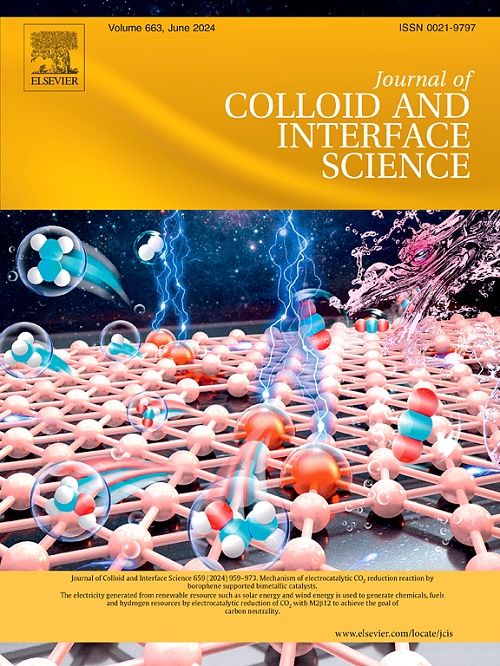A general strategy to enhance surface hydrophobicity through modifying a rough-textured surface with weakly hydrophilic elemental sulfur
IF 9.4
1区 化学
Q1 CHEMISTRY, PHYSICAL
引用次数: 0
Abstract
Lotus leaves usually get the superhydrophobicity from the presence of epicuticular wax on its multilevel micro- and nano-structured surface. It is known that the epicuticular wax is weakly hydrophilic with a contact angle of ∼ 74°, and inorganic elemental sulfur also has a weak hydrophilicity similar to the wax. Inspired by the waxy feature, here we first attempt a superhydrophobicity-harvested strategy by modifying a rough surface with weakly hydrophilic elemental sulfur. The superhydrophobicity of a series of materials including metal hydroxides, oxides, sulfides and chlorides, metals, and even hydrophilic organics, can be achieved by prefabricating their topographic textures combined with elemental sulfur surface modification. DFT calculation suggests that the presence of VS defects on the elemental sulfur coatings can make their rough surfaces have a stronger affinity for O22– than for H2O, which allows for the formation of O22–-adsorbed layer on their surface, and thus imbues the hydrophobicity or superhydrophobicity. Our study offers a new and general approach to enhance the surface hydrophobicity via inorganic rather than low surface-energy organic modification.

通过用弱亲水性元素硫修饰粗糙表面来增强表面疏水性的一般策略
荷叶的超疏水性通常是由于其多层微纳米结构表面存在表皮蜡质。已知表皮蜡具有弱亲水性,接触角为~ 74°,无机单质硫也具有与蜡相似的弱亲水性。受蜡质特征的启发,我们首次尝试了一种超疏水收集策略,即用弱亲水性元素硫修饰粗糙表面。包括金属氢氧化物、氧化物、硫化物和氯化物、金属、甚至亲水性有机物在内的一系列材料的超疏水性,可以通过预制其地形结构并结合单质硫表面改性来实现。DFT计算表明,单质硫涂层上存在VS缺陷,使得其粗糙表面对O22 -的亲和力大于对H2O的亲和力,从而使其表面形成O22 -吸附层,从而形成疏水性或超疏水性。我们的研究提供了一种新的和通用的方法,通过无机而不是低表面能的有机改性来增强表面疏水性。
本文章由计算机程序翻译,如有差异,请以英文原文为准。
求助全文
约1分钟内获得全文
求助全文
来源期刊
CiteScore
16.10
自引率
7.10%
发文量
2568
审稿时长
2 months
期刊介绍:
The Journal of Colloid and Interface Science publishes original research findings on the fundamental principles of colloid and interface science, as well as innovative applications in various fields. The criteria for publication include impact, quality, novelty, and originality.
Emphasis:
The journal emphasizes fundamental scientific innovation within the following categories:
A.Colloidal Materials and Nanomaterials
B.Soft Colloidal and Self-Assembly Systems
C.Adsorption, Catalysis, and Electrochemistry
D.Interfacial Processes, Capillarity, and Wetting
E.Biomaterials and Nanomedicine
F.Energy Conversion and Storage, and Environmental Technologies

 求助内容:
求助内容: 应助结果提醒方式:
应助结果提醒方式:


